Japanese Soba
Japanese soba is a very popular noodle dish in Japan. Healthy, versitle, and inexpensive, soba can be served in a variety of ways hot or cold, and is a staple of the Japanese diet.
![]()
Overview of Japanese Soba
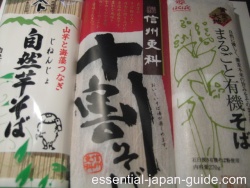
Soba noodles are greyish-brown colored noodles, about the length and thickness of Italian spaghetti, made from buckwheat flour (or sometimes a mixture of buckwheat and wheat flours). In Japan, soba is enjoyed both as a hot soup dish, and cold, in the form of plain cold noodles dipped in a chilled soy-based broth.
Soba is commonly served at home, in sit-down restaurants as a somewhat pricey dish (especially when the noodles are made fresh on site), and as a quick, cheap meal at little single-counter shops near train stations, where customers stand and down a quick serving before heading on their way.
![]()
Varieties of Japanese Soba Dishes
Hot Soba Dishes
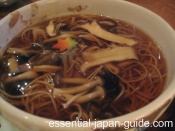
The most basic hot soba dish is a bowl of soba prepared in a hot bowl of soy- based broth called tsuyu. There are many variations of this basic hot soba dish. These include:
 Kake soba: basic hot soba topped with diced scallions.
Kake soba: basic hot soba topped with diced scallions.
 Tanuki soba: hot soba topped with bits of fried tempura batter called tenkasu.
Tanuki soba: hot soba topped with bits of fried tempura batter called tenkasu.
 Kitsune soba: hot soba topped with a thin slice of deep-fried tofu called abura-age.
Kitsune soba: hot soba topped with a thin slice of deep-fried tofu called abura-age.
 Kaki-age soba: hot soba topped with a ball of tempura usually containing fish and assorted veggies.
Kaki-age soba: hot soba topped with a ball of tempura usually containing fish and assorted veggies.
 Tempura soba: hot soba usually topped with a couple big pieces of shrimp tempura.
Tempura soba: hot soba usually topped with a couple big pieces of shrimp tempura.
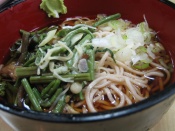
 Tororo soba: hot soba topped with a grated Japanese yam into a somewhat slimy texture similar to natto. As such, it’s an acquired taste that is definitely not for everyone.
Tororo soba: hot soba topped with a grated Japanese yam into a somewhat slimy texture similar to natto. As such, it’s an acquired taste that is definitely not for everyone.
 Sansai soba: hot soba topped with mountain veggies.
Sansai soba: hot soba topped with mountain veggies.
 Kinoko soba: hot soba topped with a mixture of Japanese mushrooms.
Kinoko soba: hot soba topped with a mixture of Japanese mushrooms.
Cold Soba Dishes
The most basic cold soba dish is called zaru soba. This dish consists of a plate or flat bamboo basket of cold noodles, often topped with dried nori (seaweed). The noodles come with a container of cold tsuyu for dipping, and wasabi and scallions for mixing into the tsuyu.
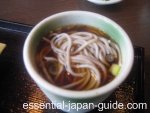
In order to eat zaru soba, first mix the wasabi and scallions into the tsuyu to taste, then scoop up a couple bite-sized portions of noodles and dunk them in the tsuyu. Let them sit for a few seconds and then eat the noodles from the tsuyu container. Repeat and enjoy!
There are also several varieties of cold soba dishes:
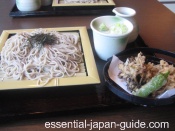
 Ten-zaru soba: this is zaru soba with a side of tempura, usually a mixture of shrimp and veggies. Dunk the tempura pieces into the tsuyu along with the soba noodles.
Ten-zaru soba: this is zaru soba with a side of tempura, usually a mixture of shrimp and veggies. Dunk the tempura pieces into the tsuyu along with the soba noodles.
 Tororo soba: A cold version of the slimy grated Japanese yam listed above.
Tororo soba: A cold version of the slimy grated Japanese yam listed above.
 Oroshi soba: cold soba noodles in a shallow cold tsuyu broth with grated daikon radish.
Oroshi soba: cold soba noodles in a shallow cold tsuyu broth with grated daikon radish.
All soba dishes can be seasoned with a dash of crushed red pepper, called shichimi-togarashi in Japanese.
![]()
Where to Eat Soba in Japan
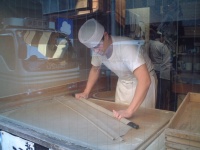
Soba is so common in Japan that you can eat it practically anywhere. There are soba shops everywhere in major cities like Tokyo, and soba restaurants are common in rural tourists spots as well.
It’s fun to experience eating cheap soba at a tachi-gui soba shop at a train station (where udon noodles are also commonly served), but all soba is not created equal, and best-tasting Japanese soba is usually found where the noodles are made fresh on site (soba noodles made on site are called “te-uchi soba.”)
One of our favorite te-uchi soba shops is Nakamura-An in Kamakura, located just off of Komachi-doori, the main stretch of shops that leads from Kamakura station. Here, you can watch fresh soba being rolled out from a window at the front of the shop. Then go inside to experience what true fresh-made Japanese soba really tastes like!
![]()
Japanese New Year Soba (Toshi-koshi Soba)
One more important and common soba eating ocassion in Japan is the custom of eating toshi-koshi soba on New Year’s Eve. “Toshi-koshi” is Japanese meaning to cross from one year into the next, and the eating of soba has become an established Japanese New Year custom.
![]()
